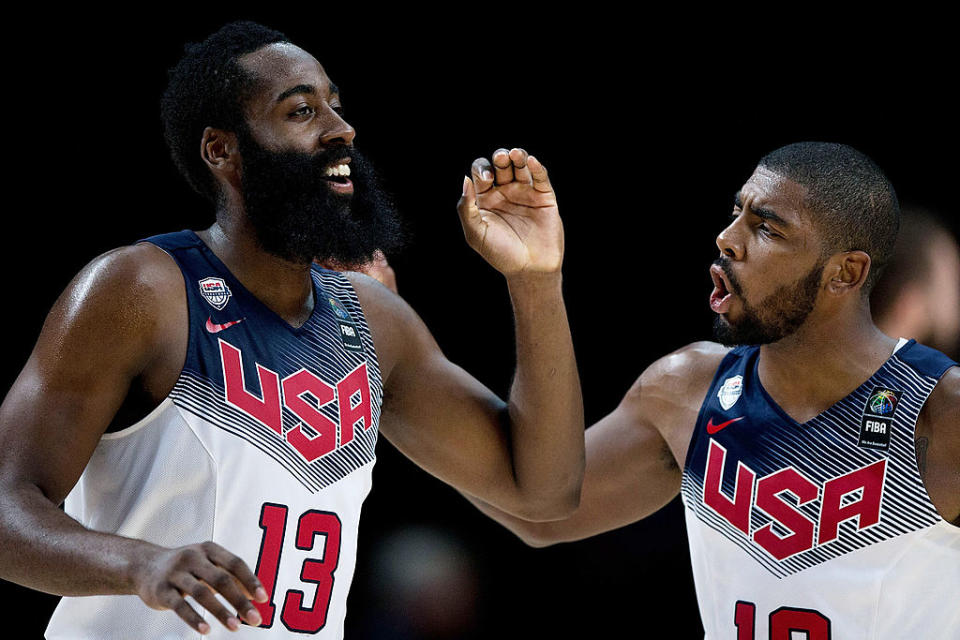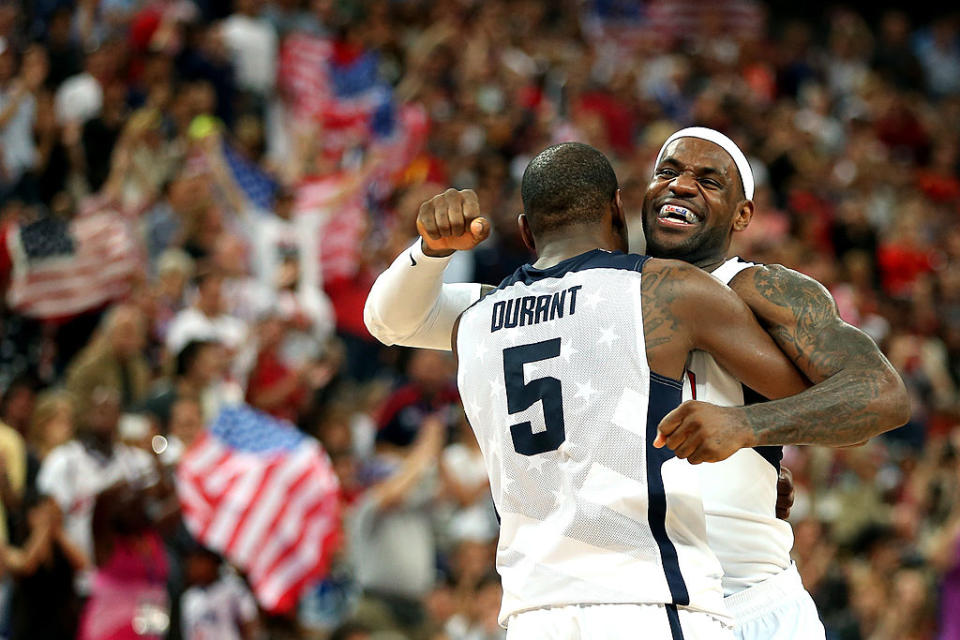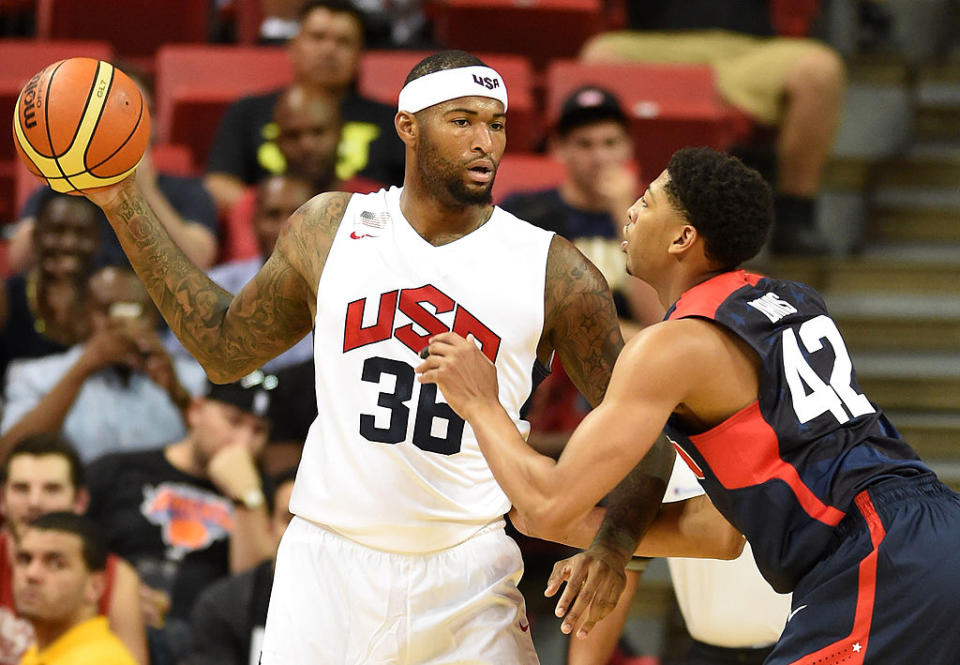What might the U.S. men's basketball roster look like in Tokyo in 2020?
After Team USA’s dominating 96-66 drubbing of Serbia at the 2016 Summer Olympics in Rio de Janeiro to win a third straight gold medal in men’s basketball, USA Basketball chairman Jerry Colangelo called upon the rest of the world to “get their act together and compete” if they want to break the stranglehold the Americans have had on the top of the men’s hoops podium over the past eight years. As the United States’ opponents set about rebuilding, revamping and reloading their national sides with an eye toward the 2020 Summer Games in Tokyo, though, it’s worth wondering: what might the U.S.’s own roster look like in four years’ time?
Given the gulf between the victory in Rio and the opening of play in Japan, there’s precious little we (think we) know about what will unfold for Team USA 2020. (Which, now that I type it out, sounds like a late-’60s “Thunderbirds” knockoff.) We know three-time NBA Coach of the Year and San Antonio Spurs legend Gregg Popovich will be stalking the sidelines. We know Carmelo Anthony, now in possession of three gold medals he wouldn’t trade for anything, will not be on Pop’s roster.
Beyond that, though, who knows? All that seems clear is that Colangelo and company will aim to avoid the same predicament in which they found themselves this summer, where two-thirds of the final roster had never played in an Olympics and 40 percent of the players had never taken the court for the senior national team.
“We can’t go back again with 10 new players,” Colangelo said Sunday, according to Marc Stein of ESPN.com. “That’s not going to happen.”
Now that we know what’s not going to happen, let’s take a stab at figuring out what might, with a purely speculative and entirely too-early look at a possible 12-man U.S. roster for the 2020 Games.
(An important note right off the top: 2015-16 NBA Rookie of the Year Karl-Anthony Towns would be a surefire selection here, but the New Jersey-born son of a Dominican mother suited up for the Dominican Republic in 2012 and 2013, and has said he intends to continue playing for that nation in the future.)

Guards: Stephen Curry, Kyrie Irving, Russell Westbrook, James Harden, Klay Thompson
It feels downright rude to leave Paul, the heroic commander of the American forces in London, off this list if he wants to be there. Ditto Lowry, who transformed himself into a top-flight NBA player and earned his stripes for the national team with his dogged defense off Coach K’s bench. But Paul’s going to be 35 when the Tokyo Games tip off, Lowry’s going to be 34, and the U.S. is working from an embarrassment of riches in the backcourt.
Irving established himself as a top U.S. point guard during the 2014 FIBA World Cup and with his (inconsistent at times, but generally effective) play in Rio, and will be a primed-and-ready 28 in Tokyo. Two-time NBA Most Valuable Player Curry will be 32, closer to the edge of his prime than the peak of his powers, but his lights-out shooting and ball-handling would seemingly make him a mortal lock for a spot should he be healthy enough to take one next time around.
Thompson struggled with his shot at times in Rio, but played a key defensive role and shook loose for big scoring performances when the U.S. needed him most. Harden served as the leading scorer and supplementary playmaker on the 2014 FIBA World Cup squad. Both offer the size and versatility to assume multiple roles as facilitators, floor-spacers, attackers and defenders in whatever capacity Pop needs depending on matchups.
Westbrook, frankly, gives me the most pause. Despite my love for his work and my excitement at the prospect of seeing him utterly unleashed in Oklahoma City this season, I can’t help but wonder how well his athleticism-dependent game will age as he hits the wrong side of 30 (he’ll be 31 in Tokyo) and whether a less explosive and relentless Russ offers as much upside for the U.S. in international competition as either a more “pure” playmaker like John Wall or D’Angelo Russell, a dead-eye shooter like Damian Lillard, Devin Booker or Bradley Beal, or a versatile wing like Rodney Hood.
For now, though, Westbrook’s superior senior national team experience — gold at both the 2010 FIBA World Championship and the 2012 London Games — give him the edge. If any of the older heads drop out, my top choices would be Wall, who I’d love to see cranked up defensively and in transition in red, white and blue, and Booker, who turned heads in Phoenix as a 19-year-old rookie and could be a full-fledged star by age 23, and who would likely feast from the shorter FIBA 3-point line.

Forwards: LeBron James, Kevin Durant, Paul George, Kawhi Leonard, Justise Winslow
Fresh off a therapeutic strafing of Argentina and Serbia in the knockout round to earn his second gold medal and reach second place on Team USA’s all-time scoring list, Durant told Michael Lee of The Vertical that he couldn’t say right now whether he’d come back for a third Summer Games at age “31, going on 32.” He did say, however, that he likes the idea of becoming the highest-scoring man ever to wear a U.S. jersey: “Just because it’s ‘Melo, I would love to pass him.” Hemming and hawing aside, if Durant wants to suit up in Tokyo, the United States’ unquestioned top offensive weapon should be a lock.
Ditto for George, the Indiana Pacers star who came back from a devastating leg injury during a Team USA scrimmage in 2014 to establish himself as arguably the best all-around player on the U.S. roster in his maiden international voyage, a multi-positional defensive nightmare capable of chipping in on offense, slotting into the starting lineup or coming off the bench, and contributing whether assigned a starring role or expected to simply be a star in his role. If it’s up to him, it sounds like he’ll be in the mix; asked by The Associated Press after Sunday’s victory about playing in four years, George smirked and replied, “Why not? Why not?”
Leonard played on the USA Select Team that scrimmaged against the national team before the 2012 Olympics in London and was bumped up to the senior squad in 2014, but withdrew from both the 2014 FIBA World Cup and the 2016 Summer Games. James made sure we all know he’s not retired from the national team and that he’d welcome the opportunity to play for Pop, but he’ll be 35 in the summer of 2020, with 17 NBA seasons and an almost incalculable amount of wear and tear on his body, and he’s made it clear that he’ll only report for duty if his body continues “to be in the form that it is today.” Given Leonard’s all-world defensive skills and relationship with Pop, and James’ star power and long history of national service, it seems likely that if they want spots, they’ll have them.
That makes four forwards; assuming Pop wants to have two centers available, that leaves only one spot remaining at the position. Griffin could be an interesting choice, finally getting the chance to play for the national team after injuries scuttled his chances in London and Rio 2016, and slotting in as a combo four/FIBA five who can rebound, facilitate offense from the post and elbow, and step out to hedge on high pick-and-rolls. With all the veteran offensive firepower already in place, though, you wonder if the U.S. would be better served using that spot on a younger, lower-usage, more defensive-minded sort who can provide energy on the wing … like, say, Winslow of the Miami Heat, whose maturity and defensive acumen impressed during his rookie season, who helped Team USA tune up for Rio last month as part of the Select Team, who looks poised to step into a bigger role in Miami this coming season, and who will be just 24 when play opens in Tokyo.
If James foregoes one last chance at gold, or one of the more established vets bows out due to injury, key Rio reserve Jimmy Butler of the Chicago Bulls (who will be 31 in 2020) could be a nice fit. Depending on how he develops over the next couple of years, Aaron Gordon of the Orlando Magic could also fill either the “youth and energy off the bench” role earmarked here for Winslow or the “combo four-five” spot envisioned for Griffin.

Bigs: Anthony Davis, DeMarcus Cousins
With only two spots left for big men in the current configuration — and with the understanding that Old Man LeBron and Nobody’s Fooled, You Are 7 Feet Tall Durant can, and sometimes should, log minutes at the five in FIBA play — we start by tapping the Brow, who moved from fresh-out-of-college mascot in 2012 to defensive linchpin for the 2014 World Cup squad, and who would likely have been the first center chosen for the 2016 squad had he not had to bow out with shoulder and knee injuries. We wrap up with Cousins, who struggled mightily at times with foul trouble and defensive positioning in Rio, but who proved to be a possession-extending monster on the offensive glass, and a steady source of both buckets and fouls drawn, when he was able to stay on the floor. Increased exposure to the international game, and to the way it’s officiated, should help extend the latter and decrease the former.
If Colangelo and Pop opt for a third big rather than a fifth guard or forward, Detroit Pistons center Andre Drummond — who just earned his first All-Star and All-NBA nods, who’ll be just 27 in 2020, and who’s been in the USA Basketball pipeline since winning U16 gold in Argentina in 2009 — could get the nod. Circling back to the defense-first/low-usage notion, 2016 medalist DeAndre Jordan would also make sense as a role-playing veteran presence; if the bosses prefer to skew young in that spot, 2016 Select Teamer Willie Cauley-Stein could fit the Jordan/Tyson Chandler mold of a rim-protector and finisher.
The most intriguing name among American bigs, though, might be Myles Turner. The long, athletic 6-foot-11 Pacers center showed a capacity as a rookie to serve as both an interior deterrent and a floor-spacing shooter, which would seem to make him a perfect fit for the international game … although maybe not just yet.
Plenty can happen between now and Tokyo, of course — injuries and ailments, stars rising and falling, circumstances changing, etc. No matter which contenders rise up to meet Colangelo’s challenge, though, the mixture of top-tier veteran talent and exciting youth at Popovich’s disposal will likely make Team USA the clear favorites to score a fourth straight Olympic gold, regardless of how the final roster shakes out.
More USA Basketball coverage from Yahoo Sports:
– – – – – – –
Dan Devine is an editor for Ball Don’t Lie on Yahoo Sports. Have a tip? Email him at devine@yahoo-inc.com or follow him on Twitter!



